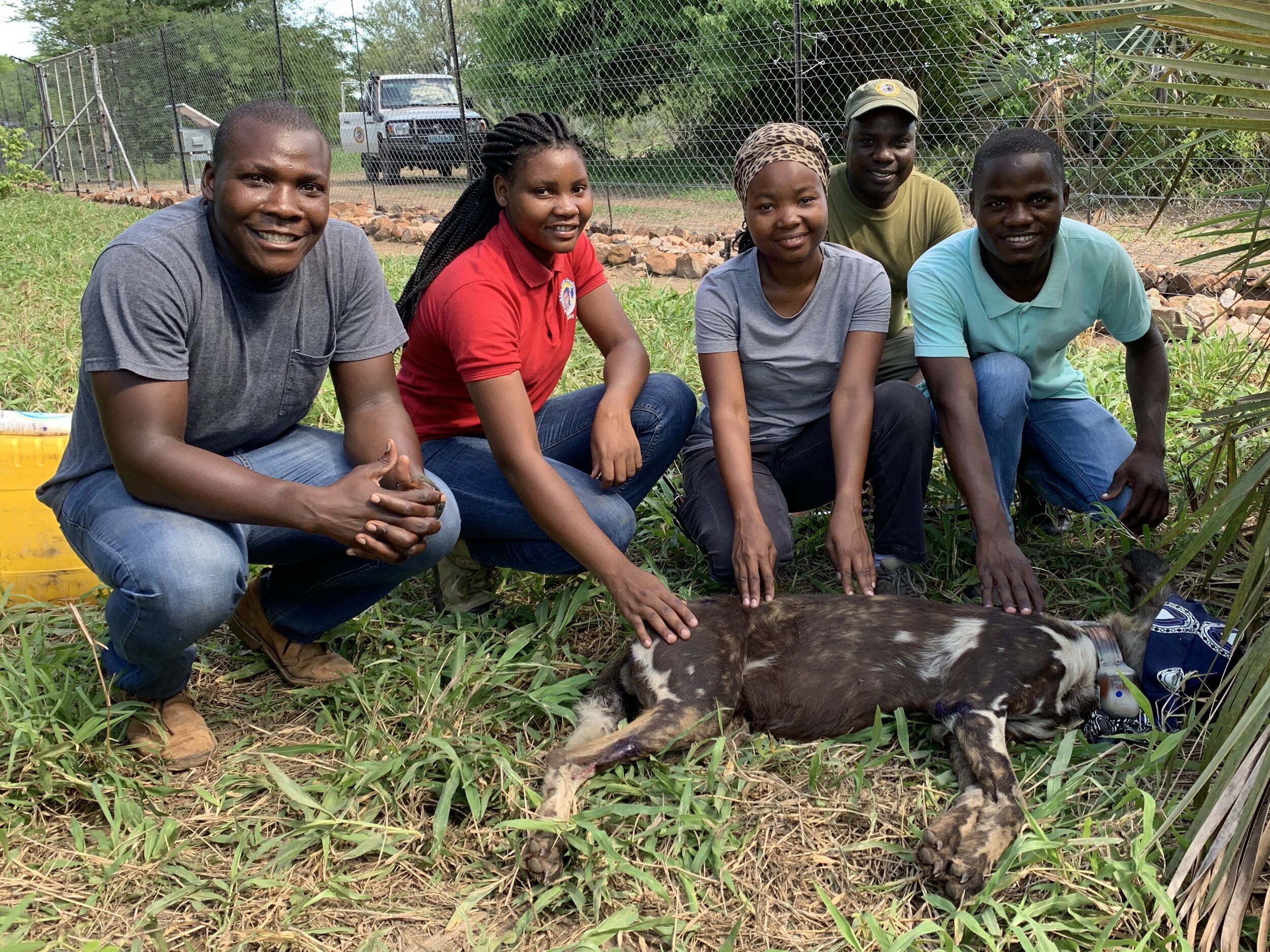Post-War Recovery of Wild Dogs in Central Mozambique
Blueprint
ASSESS
This species has been listed as Endangered on the IUCN Red List of Threatened Species since 1990. An intensive survey of large carnivores commencing in 2012, as well as WildCam Gorongosa surveys and daily tracking by eco-tourism guides in the area, yielded no sightings of Wild Dogs in Gorongosa National Park (GNP) between 2012 and 2018. Multiple stakeholders were consulted and a core reference was outlined following IUCN standards rating the viability of a reintroduction to Gorongosa. The team identified the park as a ‘recoverable’ area. The Wild Dog Advisory Group-South Africa (WAG-SA) generated a feasibility assessment to guide Wild Dog reintroductions and further assess candidate sites for range-wide expansion efforts. GNP scored 76 points (out of a possible 100) in the WAG-SA feasibility assessment.
PLAN
Given that no Wild Dog recolonizations occurred post-civil war (30 years), despite the increasing herbivore prey base and efforts to protect the landscape, conservation translocations were identified as the primary recovery strategy for GNP. In 2017, GNP and the Endangered Wildlife Trust met to discuss the details for a reintroduction program. Preliminary steps included an analysis that indicated Gorongosa staff was ready to oversee such an effort, and a plan was set in motion to construct a founding population of dogs. The goal was to receive the first pack in March 2018 (to be released in May 2018) and the second pack in 2019, with followup packs if required in 2020–2022. Additional details included obtaining wildlife permits from both Mozambique and South Africa, and identifying the location for construction of a state-of-the-art 0.5 hectare boma to house the dogs. Securing aircraft transport and veterinary support, as well as developing intensive post-release monitoring techniques for all packs were requisite in order to achieve success and track the evolution of the founder population.
ACT
The acclimatization period during which the packs were captive in the enclosure was crucial to facilitate bonding among the dogs. The GNP team implemented a daily schedule of monitoring procedures at the enclosure, recording the number of individuals, group association behavior, and aggressive interactions, concurrent with maintenance checks at the enclosure to reduce the likelihood of escapes. During this period, water in the trough was replaced every one–three days, and the Wild Dogs were fed every two–three days with freshly culled, whole waterbuck.
The reintroduction was conducted in two phases: the first in 2018 and the second in 2019, each comprising a single pack consisting of 14 Wild Dogs each. Individual photographic identification kits were compiled with information on each individual’s area of origin, age, pack and status, collar type, unique identification number, and photographs of patterns and distinguishing marks, to facilitate identifying unique individuals in subsequent observations. In both phases, the Wild Dogs were vaccinated against rabies and canine distemper viruses. These reintroductions involved transboundary cooperation between the governments of South Africa and Mozambique, technical expertise of KwaZulu-Natal veterinarians, Endangered Wildlife Trust project managers, and Bateleur pilots.
An intensive post-release monitoring program was also developed to oversee how the packs recruit individuals through reproduction and pup survival, and settle into their new area to form territories.
In addition to the work taking place on wildlife recovery, the Gorongosa Restoration Project (a long-term governmental-Carr Foundation project) leads human development (education, water/sanitation, healthcare) and post-war rebuilding of sustainable economies in the buffer-zone. Alleviating poverty is the single-most crucial achievement required to ensure the survival of the Gorongosa ecosystem into the future.
Results
In 2019, 29 pups were born, the first Wild Dogs born in GNP in decades. Although pup mortality is generally high, one year later the data showed a total of five packs and two dispersal groups were established across a range of 1,300 km2 with 53 pups born and a total population that approached 100 free-roaming individuals. This conservation translocation program represents the first reintroduction of Wild Dogs into a large, unfenced landscape in Mozambique and only the second documented on the African continent. A team of next-generation vets and wildlife biologists (all Mozambican, including Mozambique’s first woman wildlife veterinarian) now oversee translocations and monitoring of this recovering population.
The reintroduction team predicts further population expansion in Gorongosa given that 68% of the park is currently unused by Wild Dogs. The Park also monitors an extant (but highly endangered) population of Wild Dogs in the Inhamitanga Forest along the Zambezi River, and work is underway to establish a viable corridor linking the populations across the greater landscape.
Visual & Audio References
©Paola Bouley
Collaborations
Main Partners
Endangered Wildlife Trust
Administração Nacional das Áreas de Conservação (ANAC)
Additional
Contributors
The Bateleurs; WildlifeAct; Wilddog Advisory Group (Southern Africa)
Funders
Oak Foundation; USAID (Mozambique); National Geographic
Additional Resources
Content Updated as of 9/1/2020











